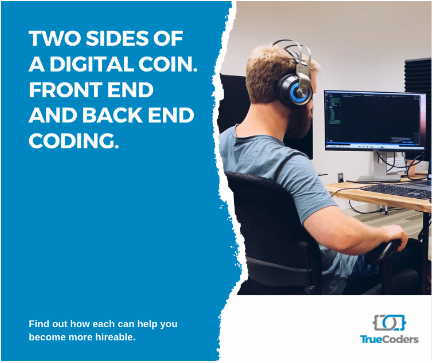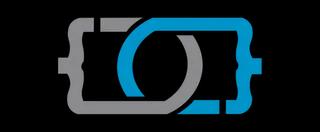Two Sides of a Digital Coin. Front End and Back End Coding.Published: April 26th, 2022• Last Updated: March 25th, 2024

A lot of people think of coding as, well, just coding. It's easy to lump everything into one category, but you can actually split coding into two main components.
These components are Front End and Back End.
These two coding elements require different skills and thought processes to tackle, but both are integral to creating quality code.
Front End
Front End elements are the front-facing aspects of software (shocking, we know) and focus on user experience.
When you browse a website or use an app, all the things you see and interact with are front-end elements – buttons, sliders, tabs, text, audio/video elements, and anything else that causes an action or conveys information to an end-user.
If you compare a piece of software to a house, front-end elements would be things like light switches, doors, wall colors, cabinet styles, etc.
Bad front-end design is very apparent. You’ve probably experienced ‘meh’ front-end design if you’ve ever rolled your eyes at a website and given up trying to figure out how to interact with it. Bad design could be a multitude of things: conflicting/gaudy colors, hard-to-read text, tabs/buttons that take you to unexpected destinations (or nowhere at all). All of these detract from the user experience.
Front end involves more intuitive questions compared to the more logic-based back-end processes. Will this text be legible on this background? Do tabs and subtabs lead to logical destinations? Could a user interact with this software if they didn’t have a mouse? These are questions that front end developers need to answer.
Back End
Back end elements are the coding elements you find “under the hood.” Remember the house analogy? If front end is made up of light switches and sink knobs, then back end is the plumbing and electrical wiring making things happen when you use those switches and knobs.
So what would be some symptoms of bad back-end design? If you’ve ever gone through the hoops of creating a user account for a site and can’t log in afterward, there’s a back-end issue. If you put in your payment information for an online purchase, but the store/distributor never receives that information, there’s a back-end issue.
Basically, if there's a problem with sending, pulling, receiving, or storing information, you’ve got a back-end problem.
Creating solid back end programming requires logic. Think of back end like a math problem. If you want solution X to happen, you write code that will cause X. Then, you test the code. If your code causes X to happen, you move on to the next problem to solve.
That’s not to say back end is devoid of the nuances you’d find in front end design. You can always improve your code, even if you do manage to get that X to work. For example, if your program pulls a store’s inventory list like it’s supposed to, you can still see if there’s any way to optimize your code to speed up the process.
Full Stack, Full Picture
Front end and back end are both pivotal to coding, so TrueCoders goes beyond teaching you one or the other by teaching you a full stack engineering.
Full stack means that you learn front end and back end programming. Full Stack developers are masters of all trades and are much more valuable in the workforce.
In both of our courses – Web Development and Software Engineering – you’ll be learning how to implement both front end and back end coding.
Why learn both? For one, you’ll be able to make better decisions as you code. If you're working on back end coding, but you also know front end, you’ll be able to proactively plan for what needs to be done when the front end work comes around.
You also won’t know what you like most until you sample everything. By experiencing front end and back end in one course, you can get a feel for where your strengths and interests lie. When you start sending your resume to software companies, you can focus on positions you know you’ll be best suited for.
Those companies will also be more interested in you as a full stack developer. They’ll know you have the skill and flexibility to tackle a variety of challenges, and they’ll be sure to reward that effectiveness.
So why wait? Whether you’re more interested in frontend or backend, user experience or code efficiency, design or logic, TrueCoders is ready to turn you into a software engineer.
